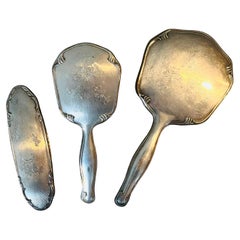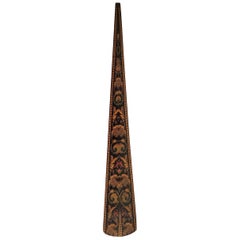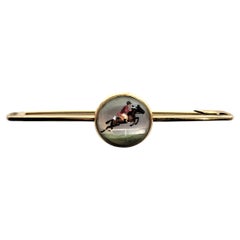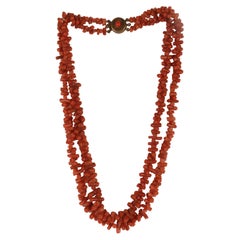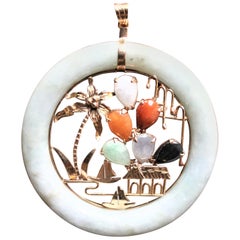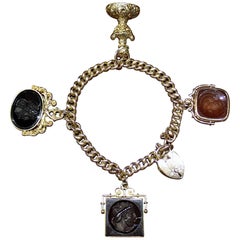English Collectible Jewelry
to
4
49
14
74
1
18
10
6
3
2
2
2
1
2
34
38
1
16
16
5
3
1
2
1
63
28
21
18
11
42,198
928
385
299
253
75
75
75
1
1
1
1
1
Place of Origin: English
Alpacca English silver metal toiletry set - circa 1900 - England
Located in Beuzevillette, FR
Very pretty toiletry set in silver metal with chiseled decoration of foliage scrolls with guilloche background including a mirror called "Face à main", and two brushes.
This set is v...
Category
Early 20th Century Art Nouveau English Collectible Jewelry
Materials
Alpaca
Rare 19th Century English Tunbridgeware Hair Pin or Slide
Located in Dallas, TX
PRESENTING an EXTREMELY UNIQUE and RARE 19C British Tunbridgeware Hair Pin/Bobbin or Slide.
This slide is unlike any of it’s kind we have seen before, it is a VERY RARE survivor.
From circa 1860 – 80 and made in Tunbridge Wells, England.
Made of walnut with gorgeous marquetry inlay on the entirety of the front with classic Tunbridgeware micro-mosaic all over the front. The rear is walnut.
The marquetry inlay appears to be various different woods, namely, maple, walnut and satinwood.
Would have been worn in a Lady’s hair bun with the micro-mosaic facing forward.
This would have belonged to a VERY ELEGANT LADY in the mid to late 19th Century.
Tunbridge ware is a form of decoratively inlaid woodwork, typically in the form of boxes, that is characteristic of Tonbridge and the spa town of Royal Tunbridge Wells in Kent in the 18th and 19th centuries. The decoration typically consists of a mosaic of many very small pieces of different coloured woods that form a pictorial vignette. Shaped rods and slivers of wood were first carefully glued together, then cut into many thin slices of identical pictorial veneer with a fine saw. Elaborately striped and feathered bandings for framing were pre-formed in a similar fashion.
There is a collection of Tunbridge ware in the Tunbridge Wells Museum and Art Gallery in Tunbridge Wells.
The famous makers of Tunbridge ware were in the Tunbridge Wells area of Kent; their most notable work was from circa 1830-1900.
Early makers of Tunbridge ware, in Tunbridge Wells in the mid-18th century, were the Burrows family, and Fenner and Co. In the 19th century, around 1830, James Burrows invented a technique of creating mosaics from wooden tesserae. Henry Hollamby, apprenticed to the Burrows family, set up on his own in 1842 and became an important manufacturer of Tunbridge ware, employing about 40 people.
Edmund Nye (1797–1863) and his father took over the Fenner company when William Fenner retired in 1840, after 30 years in partnership with him. Thomas Barton (1819–1903), previously apprenticed at the Wise factory, joined the Nyes in 1836, and worked as Nye’s designer; he took over the business in 1863 and continued there until his death.
In Tonbridge (near to Tunbridge Wells), George Wise (1703–1779) is known to have had a business in 1746. It continued with his son Thomas, and Thomas’s nephew George (1779–1869), who took over in 1806. In its early years the company made articles such as workboxes and tea caddies with prints of popular views; later items had pictures created from mosaics. Their workshop in Tonbridge, Wise’s Tunbridge Ware Manufactory, was next to the Big Bridge over the Medway; the building was demolished in 1886 to widen the approach to the bridge.
Tunbridge ware became popular with visitors to the spa town of Tunbridge Wells, who bought them as souvenirs and gifts. Articles included cribbage boards, paperweights, writing slopes, snuffboxes and glove boxes.
At the Great Exhibition of 1851, Tunbridge ware by Edmund Nye, Robert Russell and Henry Hollamby was shown; Edmund Nye received a commendation from the judges for his work. He exhibited a table depicting a mosaic of a ship at sea; 110,800 tesserae were used in making the picture.
The manufacturers of Tunbridge ware were cottage industries, and they were no more than nine in Tunbridge Wells and one in Tonbridge. The number declined in the 1880s; competent craftsmen were hard to find, and public tastes changed. After the death of Thomas Barton in 1903 the only surviving firm was Boyce, Brown and Kemp, which closed in 1927.
Marquetry was an old technique which was continued by Nye and Barton to create images such as birds or butterflies.
‘Green Oak’ as caused by the fungus Chlorociboria aeruginascens.
Stickware and half-square mosaic was invented by James Burrows in about 1830: a bunch of wooden sticks of different colours, each having triangular or diamond-shaped cross section, were tightly glued together; in the case of stickware, the resulting block was dried, then turned to form an article such as the base of a pincushion. For half-square mosaic, thin slices were taken from the composite block, and applied to a surface.
Tesselated mosaic, was a development by James Burrows of half-square mosaic; it was adopted by George Wise and Edmund Nye. Minute tesserae were used to form a wide variety of geometric and pictorial designs.
Many sorts of wood were used for the various colours; about 40 were in regular use. Only natural colors were used; green was provided by “green oak”, produced by the action of fungus on fallen oak. Designs for articles were often taken from designs of Berlin wool work.
Category
Late 19th Century High Victorian Antique English Collectible Jewelry
Materials
Satinwood, Walnut
Antique English Horse Jumping or Steeplechase 9 Karat Yellow Gold Brooch or Pin
Located in Hamilton, Ontario
This antique brooch or pin is unsigned, but presumed to have originated from England and date to approximately 1900 and done in the period Edwardian style. The pin is composed of nine karat yellow gold with a glass medallion in the center portraying a man dressed in classic period attire mounted on a jumping horse. The medallion is hand-crafted and either reverse painted, or enameled and mounted to the bezel. The bezel is marked on the back for nine karat gold...
Category
Early 20th Century Edwardian English Collectible Jewelry
Materials
Gold
Sciacca coral necklace, England end of 19th century.
Located in Milan, IT
The necklace features a double strand of rod-shaped Sciacca coral elements juxtaposed at right angles in the threading. The round clasp is made of golden metal and features a central...
Category
Late 19th Century Antique English Collectible Jewelry
Materials
Coral, Metal
Midcentury Era White Jade and 14-Karat Yellow Gold Chinoiserie Styled Pendant
Located in Hamilton, Ontario
This jade and yellow gold pendant is unsigned, but presumed to have been made in Europe, likely England, in circa 1965 in a Chinese inspir...
Category
Mid-20th Century Chinoiserie English Collectible Jewelry
Materials
Jade, Multi-gemstone, Gold
Georgian Gold Bracelet with Locket and Four Carnelian Intaglios
Located in Hamilton, Ontario
Gold bracelet with locket and four beautifully carved carnelian intaglios from the Georgian period. The bracelet and locket is 9-karat antique gold while the intaglios tested for 14-...
Category
Early 19th Century Georgian Antique English Collectible Jewelry
Materials
Gold
A Grand Tour lava cameo depicting a dyonisiac female figure, England circa 1890.
Located in Milan, IT
Big oval cameo made of lava and mounted in patinated silver with a smooth profile. On the front is sculpted a female bust with a rich hairstyle in which decorative elements belonging...
Category
Late 19th Century Antique English Collectible Jewelry
Materials
Lava, Silver
Antique English Wood & Brass Dresser Top Pocket Watch Stand & Vide Poche
Located in Hamilton, Ontario
This large wooden dresser top pocket watch stand and vide poche is unmarked, but believed to have been made in England in approximately 1890 in th...
Category
Late 19th Century Victorian Antique English Collectible Jewelry
Materials
Brass
Victorian gold brooch-pendant with topaz. England, 1870.
Located in Milan, IT
A thin gold necklace with elongated links and a circular lobster clasp holds a pendant brooch with a central body and oblong sides. Made of 14 Kt go...
Category
Late 19th Century Antique English Collectible Jewelry
Materials
Gold
Chain seal in silver vermeil, garnet and carnelian. England 1870.
Located in Milan, IT
Chain seal in silver vermeil, garnet and carnelian, England 1870.
The seal features an oval carnelian board with a beveled edge, virgin. This is set in a straight invitation cushion ...
Category
Late 19th Century Antique English Collectible Jewelry
Materials
Carnelian, Silver
Antique Miniature Portrait with an 18-Karat Yellow Gold Frame & Fitted Case
Located in Hamilton, Ontario
This well executed miniature portrait was made in England in approximately 1900 in the period Edwardian style and comes with its original fitted leather case. The painting is unsigne...
Category
Late 19th Century Edwardian Antique English Collectible Jewelry
Materials
Gold
Antique gold and carnelian chain seal, England 1870.
Located in Milan, IT
Antique 18 Kt. gold and carnelian chain seal. The matrix is never engraved carnelian, oval in shape with beveled edges. The back of the carnelian appears convex. A flat gold band emb...
Category
Late 19th Century Antique English Collectible Jewelry
Materials
Carnelian, Gold
English Silver-Mounted Swirled Glass Perfume Bottle
Located in New York, NY
English Silver Mounted Swirled Glass Perfume Bottle
The glass Stevens and Williams (unmarked). The Victorian silver -Birmingham 1889 Makers: S...
Category
1880s Antique English Collectible Jewelry
Materials
Sterling Silver
White Vitreous Paste Cameo of Emma, Lady Hamilton, Attributed William Tassie
Located in Lymington, Hampshire
A white vitreous paste cameo of Emma, Lady Hamilton, attributed to William Tassie after Filipo Rega, of oval form depicting Emma facing right with her hair in a Grecian style, Englis...
Category
Early 1800s Antique English Collectible Jewelry
Materials
Vitrolite
Antique English Battersea Locket in the Form of a Clock
Located in Tampa, FL
An 18th century English Battersea locket enameled with a clock face on one side and a floral decoration on the reverse.
Category
1790s Antique English Collectible Jewelry
Materials
Enamel
Recently Viewed
View AllMore Ways To Browse
Swedish Wooden Plates
Table Crucifix
Table Nuit
Tea Cosy
Teak Wood Elephants
Ten Drawer Dresser
Tennis Bronze
Terra Cotta Plate
Terracotta Vase Floor
Thayer Coggin Burl Wood
The Howell Company
Thiebaut Frered
Tibetan Painted Cabinets
Tinned Copper Tray
Tip Trays Vintage
Tommaso Spinzi
Travertine Top Nightstands
Triple Wardrobe
